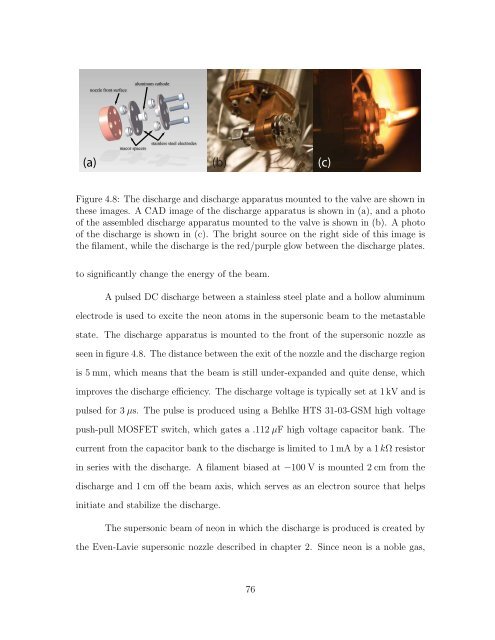Experiments with Supersonic Beams as a Source of Cold Atoms
Experiments with Supersonic Beams as a Source of Cold Atoms
Experiments with Supersonic Beams as a Source of Cold Atoms
Create successful ePaper yourself
Turn your PDF publications into a flip-book with our unique Google optimized e-Paper software.
nozzle front surface<br />
aluminum cathode<br />
stainless steel electrodes<br />
macor spacers<br />
(a) (b)<br />
(c)<br />
Figure 4.8: The discharge and discharge apparatus mounted to the valve are shown in<br />
these images. A CAD image <strong>of</strong> the discharge apparatus is shown in (a), and a photo<br />
<strong>of</strong> the <strong>as</strong>sembled discharge apparatus mounted to the valve is shown in (b). A photo<br />
<strong>of</strong> the discharge is shown in (c). The bright source on the right side <strong>of</strong> this image is<br />
the filament, while the discharge is the red/purple glow between the discharge plates.<br />
to significantly change the energy <strong>of</strong> the beam.<br />
A pulsed DC discharge between a stainless steel plate and a hollow aluminum<br />
electrode is used to excite the neon atoms in the supersonic beam to the met<strong>as</strong>table<br />
state. The discharge apparatus is mounted to the front <strong>of</strong> the supersonic nozzle <strong>as</strong><br />
seen in figure 4.8. The distance between the exit <strong>of</strong> the nozzle and the discharge region<br />
is 5 mm, which means that the beam is still under-expanded and quite dense, which<br />
improves the discharge efficiency. The discharge voltage is typically set at 1 kV and is<br />
pulsed for 3 μs. The pulse is produced using a Behlke HTS 31-03-GSM high voltage<br />
push-pull MOSFET switch, which gates a .112 μF high voltage capacitor bank. The<br />
current from the capacitor bank to the discharge is limited to 1 mA by a 1 kΩ resistor<br />
in series <strong>with</strong> the discharge. A filament bi<strong>as</strong>ed at −100 V is mounted 2 cm from the<br />
discharge and 1 cm <strong>of</strong>f the beam axis, which serves <strong>as</strong> an electron source that helps<br />
initiate and stabilize the discharge.<br />
The supersonic beam <strong>of</strong> neon in which the discharge is produced is created by<br />
the Even-Lavie supersonic nozzle described in chapter 2. Since neon is a noble g<strong>as</strong>,<br />
76
















